What Links Here?
Outbound Links
- ⭐ john-bambrick-b1791
- ⭐ robert-bambrick-b1827
- 🖼️ Death_of_Capt_Bambrick_s-l1600.jpg
- 🖼️ the_death_of_capt_bambrick_cover_ill.jpg
- 🖼️ captain_bambrick_story_united_service_magazine.png
- 🖼️ captain_bambrick_memorial_tablet.png
- 🖼️ captain_bambrick__capt_note.png
- 🖼️ Bade of the 7th dragoons
- 7th Dragoon Guards at BritishEmpire.co.uk
- The Cape and the Kaffirs, "A Diary of Five Years' Residence in Kaffirland", by Harriet Ward
Robert Bambrick (b1798)
Ah, Captain Bambrick.
Brother of my direct ancestor (John Bambrick (b.1791)) and uncle of my direct ancestor Robert Bambrick. we don't know a heck of a lot about Captain Robert, but what we do know is highly interesting, and we certainly know how and when he died -- as it was depicted on The Illustrated London News.
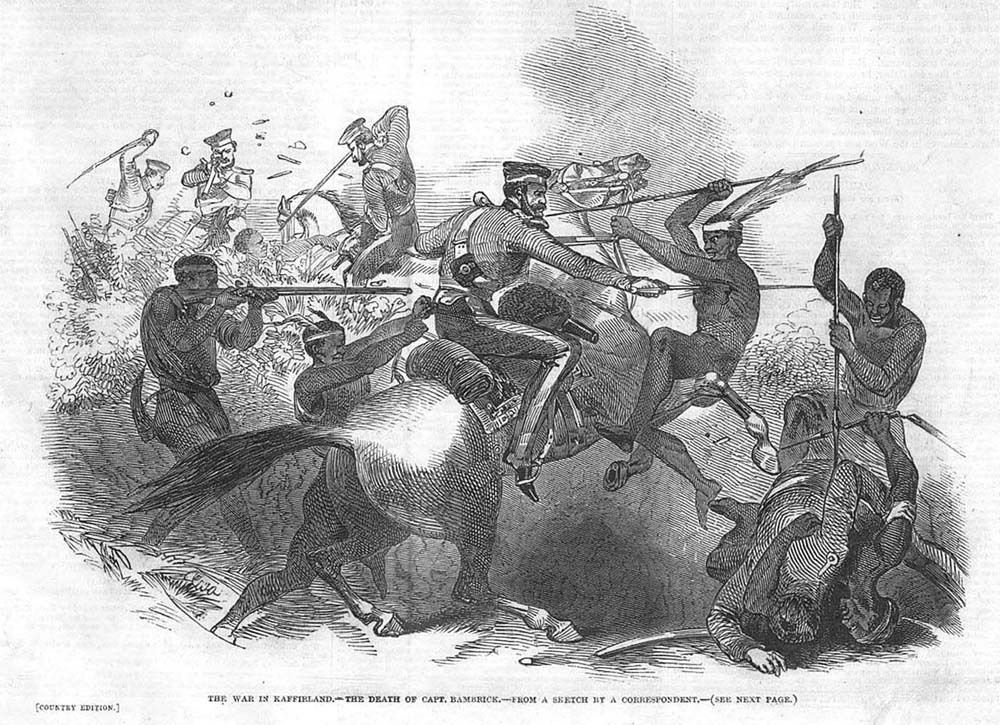
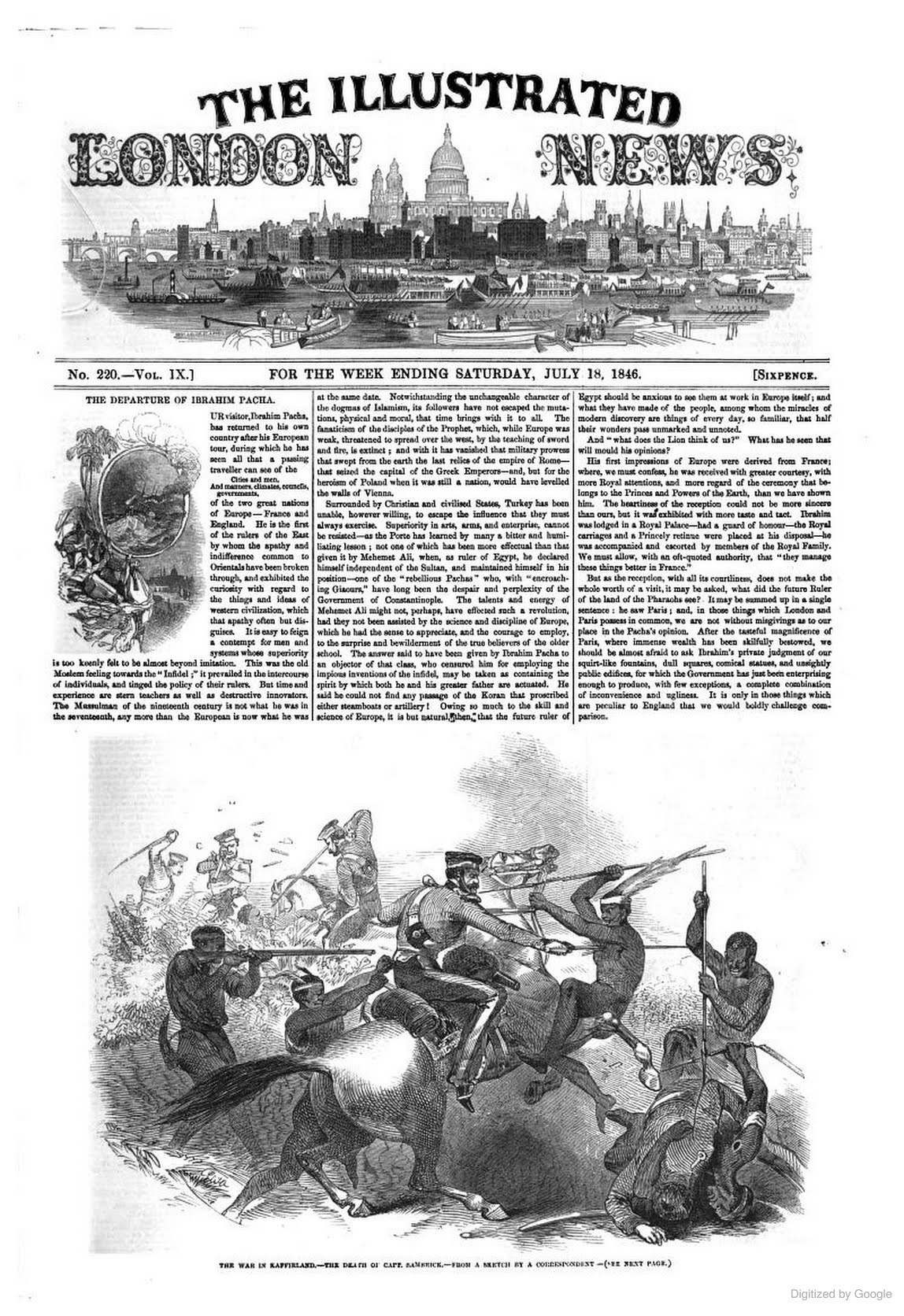
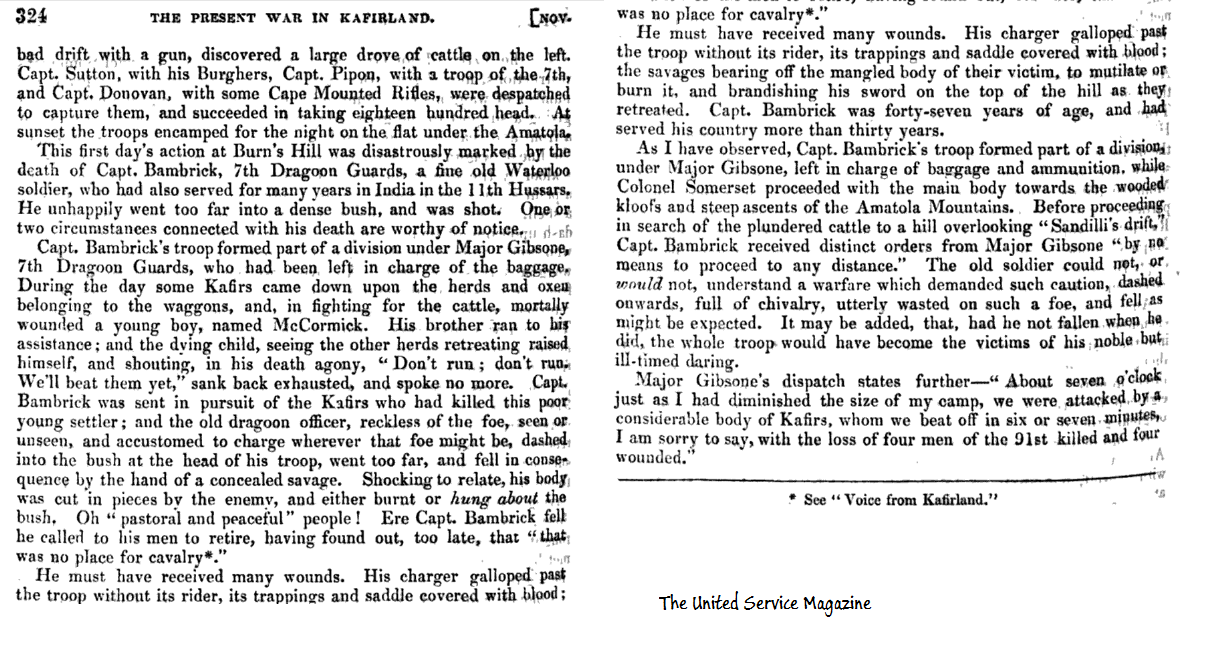
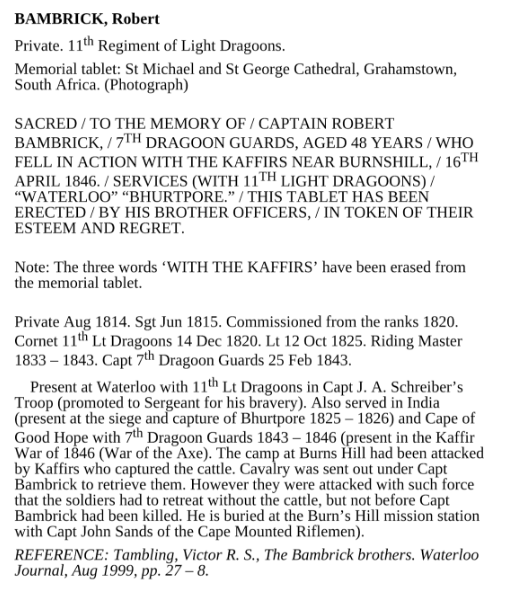
...From Cornet to Lieutenant by Purch.
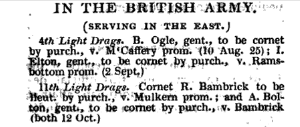

The Death of Captain Bambrick, 16th April 1846
War was declared on the Xhosa on 21st March 1846. Two columns were organised under Lieut-Col Richardson and Colonel Henry Somerset, the CO of the Cape Mounted Rifles, consisting of the 7thDG, CMR, 91st Foot and artillery. They headed for Sandile's laager at Burns Hill but when they arrived the tribe had moved on towards the Amotola Hills. A detachment was left at Burns Hill with the baggage wagons, while the two columns carried on. This detachment was commanded by Major Gibsone and included Captain Bambrick's Troop of 7thDG. Bambrick was a veteran who had served 31 years in the army. He had been in the 11th Light Dragoons and was at the siege of Bhurtpore in 1826. Bambrick's Troop were sent off to the Keikama River to investigate the sound of shots. When he got there he found some stolen cattle but no tribesmen. He led his men into some dense scrub that enclosed the banks of the river but fell into an ambush. The Xhosa were armed with muskets and Bambrick was shot. He shouted to the NCOs to withdraw, which they did with great difficulty as the thorns tore at the horses and riders. Major Gibsone arrived with men of the 91st and two RA guns which dispersed the tribesmen and they ran off with the head of Captain Bambrick as a trophy to show Chief Sandile.
The first day’s action at Burn’s Hill was disastrously marked by the death of Captain Bambrick, 7th Dragoon Guards, a fine old Waterloo soldier, who had also served for many years in India, in the 11th Hussars. He unhappily went too far into a dense bush, and was shot. One or two circumstances connected with his death are worthy of notice.
Captain Bambrick’s troop formed part of a division under Major Gibsone, 7th Dragoon Guards, who had been left in charge of the baggage. During the day, some Kaffirs came down upon the herds and oxen belonging to the waggons, and in fighting for the cattle, mortally wounded a young boy, named McCormick. His brother ran to his assistance; and the dying child, seeing the other herds retreating, raised himself, and shouting, in his death-agony, “Don’t run! don’t run! We’ll beat them yet!” sank back exhausted, and spoke no more. Captain Bambrick was sent in pursuit of the Kaffirs who had killed this poor young settler; and the old dragoon officer, reckless of the foe, seen or unseen, and accustomed to charge wherever that foe might be, dashed into the bush at the head of his troop, went too far, and fell in consequence by the hand of a concealed savage. Shocking to relate, his body was cut in pieces by the enemy, and either burned or hung about the bush. Oh “pastoral and peaceful” people! as Missionary Society Agents have styled them. Ere Captain Bambrick fell, he called to his men to retire, having found out, too late, that “that was no place for cavalry.”
He must have received many wounds. His charger galloped past the troop without its rider; its trappings and saddle were covered with blood; while the savages bore off the mangled body of their victim, brandishing his sword on the top of the hill as they retreated. Captain Bambrick was forty-seven years of age, and had served his country more than thirty years.
As I have observed, Captain Bambrick’s troop formed part of a division, under Major Gibsone, left in charge of baggage and ammunition, while Colonel Somerset proceeded with the main body towards the wooded kloofs and steep ascents of the Amatola Mountains. Before proceeding in search of the plundered cattle to a hill overlooking “Sandilla’s drift,” Captain Bambrick received distinct orders from Major Gibsone “by no means to proceed to any distance.” The old soldier could not, or would not, understand a warfare which demanded such caution, dashed onwards, full of chivalry, utterly wasted on such a foe, and fell, as might be expected. It may be added, that, had he not fallen when he did, the whole troop would have become the victims of his noble but ill-timed daring.
~ ~ ~
“November 25th.—We have had melancholy proof of the sickness in the field in the death of Captain Knight, 7th Dragoon Guards. Although he went into the field in good health, the cold and privation he endured on service in a few weeks laid him on his death-bed, with disease of the liver. In his military career, he was most fortunate, obtaining his commission as Cornet in the 7th in 1841, and his troop, by the death of Captain Bambrick, killed in action at Burn’s Hill, on the 16th of April, 1846.”
~ ~ ~
No response followed the raising the tiger-skin banner, and the result was the breaking-up of the conference, and the safe return of the troops to quarters. It is most probable the armed scout was deterred by superstitious motives from trying a fourth time to give the signal of destruction. Had the Gaikas risen en masse, as was intended, what a fearful slaughter there would have been at the moment, and how terrible would have been the effect on this devoted Colony!
The day that meeting took place, my little girl and I were travelling with a small party, on horseback, through the bush not far from Block Drift. Captain Bambrick had accompanied us part of the way on the first day’s journey: it was the last time I ever saw him. As we wound along a splendid road, lately made between Post Victoria and Botha’s Post, a distance of nine miles, I looked up the mountain-sides, clothed with euphorbia, mimosa, and innumerable shrubs, and observed that probably those silent thickets were tenanted by human beings, who could watch our progress unobserved. We had no fear. “The word had not been given to kill;” and, though they were not aware of this expression on the part of the Kaffirs, we had every reason to believe they would never fire the first shot. I am doubtful as to the truth of the premeditated onslaught at Block Drift; for they did not fire the first shot in the Amatola Mountains.
~ ~ ~
Witchcraft is working its mischief in Kaffirland, accompanied with the most revolting ceremonies. After the first affair on the Amatolas, Sandilla presented Umyeki, one of his numerous fathers-in-law, with a trophy of victory. The skull, skin, and right hand of our unfortunate friend, Captain Bambrick, 7th Dragoon Guards, were considered by the young Gaika chief as worthy offerings to this celebrated witch-doctor, or worker of spells. These wizards outrival the chiefs in power, and have hitherto carried on their incantations with a success that baffles both missionary and military exertions.
~ ~ ~
“April 20th, 1847.—To-day is the anniversary of our sad intelligence from the Amatolas, with its list of killed and wounded. It is a singular fact that the Kaffirs themselves dislike to be questioned concerning the remains of poor Captain Bambrick, but have no hesitation in speaking of other sufferers.
—Extracted from The Cape and the Kaffirs, "A Diary of Five Years' Residence in Kaffirland", by Harriet Ward